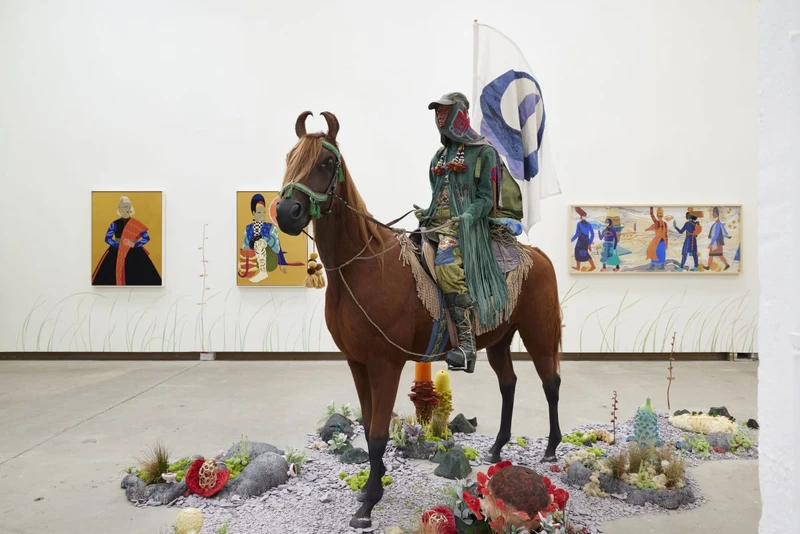Rajni Perera: Traveller
4 Jun-6 Aug 2022
PV 3 Jun 2022, 6-8pm


Rajni Perera expands on her visionary Traveller series of paintings, pollution wear and sculpture for both a large-scale exhibition in Eastside Projects’ main gallery and a public mural on the eastern banks of the River Rea on the edge of Highgate and Balsall Heath.
Set after the end of white suprematism and ecological collapse, Perera’s ongoing series builds a complex, energised diaspora of climate refugees, habitats and survival mechanisms set against rapidly transforming landscapes. Perera’s travellers are imagined as ‘immigrant futures’, the artist’s science fiction metaphor for cross border resilience. The mutated bodies of the travellers indicate an evolutionary timescale thousands of years into the future, yet their humanoid shapes still connect them to earthly pasts. Escaping from a planet no longer able to support human life, and extending out of this world, and into space, each character occupies future worlds with a noble confidence and intelligence, interconnected through self and community knowledge maintained and valued as living culture.
Perera’s vivid artworks animate ideas and issues related to immigration, mutation, hybridity, ancestorship and futurity. Depicting diasporic identities and dream worlds, they emerge from her own reflections on our current reality – “As immigrant cultures get stripped away and homogenised in nation-states — or that being a goal of the nation-state as we know it — ideas around spacefaring and off-worlding stand in as a metaphor for immigrant resilience to retain our cultures, and survive and thrive.”
Rather than the European adventurers that typically dominate science fiction stories of spacefaring and off-worlding, Perera imagines the kinfolk of Black and Brown people as her brave protagonists. She casts migrants, so often characterised as aliens, as first explorers.
A Starry-eyed Subspecies (2022) is a major new sculptural work featuring a life-size Traveller and Post-Horse traversing a mutated and poisoned landscape left behind by greedy and wealthy corporate nations. The installation approaches the feeling of searching in a very particular sense, familiar to many – leaving unsafe places to find safe ones, trying to take care of one’s kin and family, feeling isolated, and needing to prevail despite unreasonable situations and circumstances.
Traveller and Post-Horse are set in a mutated habitat produced by Birmingham artist Matt Gale in conversation with Perera and initially imagined whilst walking along the River Rea, the small main river that runs South West to North East through the centre of Birmingham, where you can find Perera’s new large scale Traveller mural work.
Perera’s travellers and post-beings are born out of an approach she describes as “immigrant styles and mashups, like really brightly coloured plastics and neoprenes with ancestral patterns and very region-specific things that you would wear to temple and to church or mosque and then come back home.” An approach informed by the multi-ethnic neighbourhoods of Perera’s childhood continues to influence her worldview.
In the case of climate refugees, it is a desperate search for basic life needs. As the colonial-capitalist project begins to heavily press down on its billions-strong oppressed populations, hunger, thirst, pollution and displacement become some of the most ignored yet prevalent issues the majority of the human race is directly faced with. As we begin to question abundance as a birthright for all, the glaring question becomes “at what cost? And to whom?”
Alongside projects by Amy Ching-Yan Lam, Jon McCurley and Thenjiwe Niki Nkosi, Rajni’s project is part of the Birmingham 2022 Festival. This programme is supported by the Heritage Lottery Fund, Arts Council England, Canada House, Canada Council for the Arts and British Council.